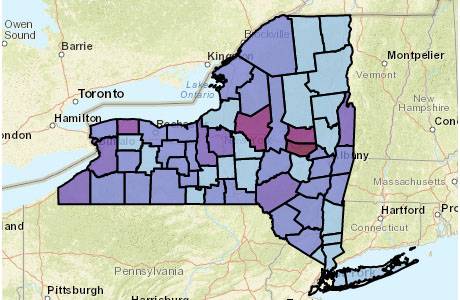Public Health Column: Lower your risk of lead exposure this fall
Press release:
Before you start your fall cleanup consider the age of your home and whether or not you may have a lead hazard.
“Lead poisoning can affect anyone, but is especially harmful to pregnant women, infants and small children who are growing rapidly,” said Paul Pettit, Public Health director for Genesee and Orleans Counties.
Lead poisoning can cause miscarriages and stillbirths, high blood pressure (hypertension), nerve disorders, memory and concentration problems and muscle and joint pain and in children it can lower IQ, cause growth problems, kidney damage, behavior problems, anemia and hearing loss.
If lead poisoning is not taken care of, it can also cause permanent damage to various organs in both children and adults. You may or may not experience any signs or symptoms of lead poisoning. State law requires all children be tested at age 1 and again at age 2. Contact your primary care doctor to be tested.
Federal law requires landlords and contractors who are hired for renovations, repair and painting in homes, childcare centers and schools built before 1978 that disturb painted surfaces, to be certified and follow specific practices to prevent lead contamination.
This law is the EPA’s Lead Renovation, Repair and Painting (RPR) Rule. Lead-based paint is especially problematic on surfaces that children can chew on such as windowsills, doors and doorframes, stairs, railings, banisters, porches and fences. Lead can also be found in drinking water in homes that have plumbing with lead or lead solder.
“If you suspect that your house has lead hazards, here are some important things you can do to protect your family,” Pettit said.
- Take advantage of the Free Lead Testing Pilot Program: A $1.5 million state program to test for lead in drinking water is available to New York State residents. Provides residents who are served by either a private well or public water system with an opportunity to have their residential drinking water tested for free. To sign-up visit, https://health.ny.gov/environmental/water/drinking/lead/free_lead_testing_pilot_program.htm.
- If you rent, call the landlord immediately to report peeling or chipping paint.
- Damp mop and damp dust often. Clean up paint chips right away and clean all other surfaces with general all-purpose cleaner.
- Let your cold water run for a minute before using it for making baby formula, drinking, brushing your teeth and cooking to flush lead picked up from pipes. Do NOT use warm tap water to make baby formula.
- Wash children’s hands and toys often to wash off any lead dust. Keep them way from chipping paint and prevent destructive behaviors like chewing on painted surfaces.
- Always hire certified contractors for work that will disrupt paint in housing or child occupied buildings before 1978 or get properly trained and certified yourself. For a certified firm check this site: http://cfpub.epa.gov/flpp/searchrrp_firm.htm.
For more information about the Renovation, Repair and Painting Rule (RRP) visit the Environmental Protection Agency website at www.epa.gov/lead/pubs/renovation.htm or call the National Lead Information Center at 1-800-424-LEAD.
To learn about additional sources of lead visit, https://www.health.ny.gov/environmental/lead/sources.htm.
For information about services that your local health department provides visit:
- Genesee County Health Department at 344-2580, ext. 5555, or visit their website at www.co.genesee.ny.us/departments/health/index.html;
- Orleans County Health Department at 589-3278 or check out their website at: www.orleansny.com/publichealth;
- Wyoming County Health Department at 786-8890 or visit their website at www.wyomingco.net/health/main.html.

